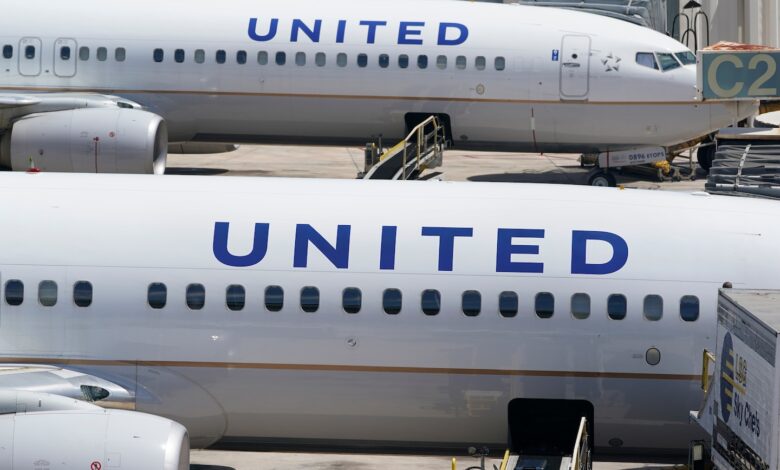United Airlines rethinks Boeing 737 Max’s place in its fleet

Inspections at United Airlines since the accident have turned up similar issues.
Minicucci’s remarks, made to NBC News, came the same day that executives at United said they expect to report a first-quarter loss as a result of the grounding. They also said they are weighing alternative planes for future growth out of concern that the accident — which prompted the Federal Aviation Administration to ground more than 100 of the planes indefinitely — will further delay certification of a new, larger version of the plane, the Max 10.
The financial and operational impact of the grounding could be even more significant for Alaska Airlines, which is scheduled to report earnings on Thursday. Although the carrier has a smaller number of Boeing Max 9 aircraft, the 65 planes affected make up about 20 percent of Alaska’s total fleet.
“The reality is that with the Max grounding, this is the straw that broke the camel’s back with believing that the Max 10 will deliver on the schedule we had hoped for,” Michael Leskinen, United’s chief financial officer, told analysts during an update on the airline’s financial results.
United is not canceling its order for Max 10s, but the company no longer expects them to be delivered on time, chief executive Scott Kirby said. The carrier has orders for 277 Max 10 jets, with an option to buy 200 more. In 2017, when the deal was made, United expected the planes to be delivered in 2020.
“Boeing’s not going to be able to meet their contractual deliveries on at least many of those airplanes, and I’ll just leave it at that,” Kirby said.
United had hoped to incorporate Max 10 jets into its future growth plans, but uncertainty surrounding when the FAA will certify the plane as ready for passengers means the carrier will have to move forward without counting on those plane deliveries.
Kirby said he remained confident in the airplane manufacturer.
“They’re going through a rough patch right now, but I believe that Boeing is across the board from top to bottom committed to changing and fixing it,” Kirby said.
When asked whether Boeing has a serious quality control problem that goes beyond just one plane, Minicucci said that is a concern.
“This is the issue that’s at question right here, which is what is Boeing going to do differently on their quality program to make sure that when we get an airplane, it’s at the highest degree of excellence,” he said. “And that’s what’s got to be different going forward.”
United’s financial forecast and the executives’ comments underscore the widening fallout from the Jan. 5 incident on the Alaska flight, in which a plug covering an optional emergency exit flew off the side of the plane, leaving it with a gaping hole. No one was seriously hurt, but the FAA grounded the plane the following day and has been working with Boeing on a plan for inspecting the other Max 9s currently in service to ensure their safety.
The grounding has led to thousands of canceled flights at both United and Alaska and shaken confidence in Boeing.
The disruptions come after a relatively smooth year for the airline industry, following the bumpy recovery from the coronavirus pandemic, with the cancellation rate dropping to 1.2 percent, according to federal data. The improved conditions boosted airlines’ finances, with United reporting $600 million in profits for the final quarter of 2023.
Stan Deal, the head of Boeing’s airliner division, acknowledged the disruptions Tuesday and said the company was following the FAA’s lead.
“We have let down our airline customers and are deeply sorry for the significant disruption to them, their employees and their passengers,” Deal said in a statement. “We are taking action on a comprehensive plan to bring these airplanes safely back to service and to improve our quality and delivery performance.”
Boeing did not respond to questions about the future of the Max 10, which is still under a prelaunch review by the FAA. But it said that on Thursday, it will hold the first of several “quality stand downs” at the Renton, Wash., factory where it builds 737 Max aircraft. Teams will pause for a day to “take part in working sessions focused on quality,” according to a company memo. The action is one of several Boeing announced as part of its efforts to rebuild trust in the company.
Kirby said United’s technical team has been working 18-hour days over the past several weeks to ensure the Max 9 will be able to return to service safely when it is ungrounded.
Minicucci told NBC that preliminary inspections have taken about 10 hours per door. Both carriers are still awaiting clearance from the FAA to complete formal inspections. Once the FAA issues its directive, Minicucci said, it will take several days to complete all the inspections.
The FAA, for its part, has said there is no timeline for when the Max 9 jets will be cleared to resume flying.
United is a major Boeing customer. In June 2021, the airline announced its largest aircraft order in company history: 200 Boeing 737 Max aircraft and 70 Airbus A321neos. At the time, the order was a huge boost for the 737 Max and the largest by a U.S. carrier after the FAA certified they were safe to fly again following fatal crashes in Indonesia and Ethiopia.
The cause of the Alaska incident is still under investigation, with officials seeking to determine whether bolts designed to hold the plug in place were properly installed. That has raised fresh questions about Boeing’s quality control. The FAA has launched a separate review of the company’s manufacturing process, and Boeing has appointed a new internal adviser to carry out an internal review. Minicucci said that Alaska also has increased its oversight of Boeing’s production line.





